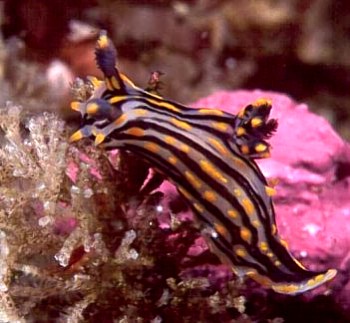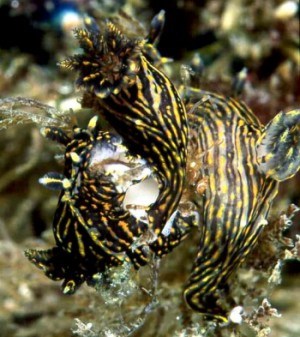
Polycera atra
MacFarland, 1905
Order: NUDIBRANCHIA
Suborder: DORIDINA
Superfamily: ANADORIDOIDEA
Family: Polyceridae
Subfamily: Polycerinae
DISTRIBUTION
Cape Arago, Oregon to Baja California, Mexico (Behrens, 1991)
PHOTO
feeding on bryozoan Bugula, Shaw's Cove, Laguna Beach, California. Photo: Bruce Wight.
Characterised by its bluish black longitudinal lines and oblong yellow tubercles. Grows to about 20mm in length. Feeds on the arborescent bryozoan Bugula.
See Bruce Wight's message below for more photos.
Reference:
• MacFarland, F.M. (1905). A preliminary account of the Dorididae of the Monterey Bay, California. Proceedings of the Biological Society of Washington, 18: 35-54
• MacFarland, F. M. 1966. Studies of opisthobranchiate mollusks of the Pacific coast of North America. Memoirs of the California Academy of Sciences, 6: 1-546, pls. 1-72.
Rudman, W.B., 2000 (July 4) Polycera atra MacFarland, 1905. [In] Sea Slug Forum. Australian Museum, Sydney. Available from http://www.seaslugforum.net/find/polyatra
Related messages
Re: Polycera atra from California
July 1, 2008
From: Wesley M.Farmer
Concerning message #20863:
Hi Clinton,
Did you look at the radula for the very white Polycera atra? Wondered if you ruled out look-a-likes? Why would you think it was a white variety of the more typical variety?
Wes Farmer
wmfarmer13@adnc.com
Farmer, W., 2008 (Jul 1) Re: Polycera atra from California. [Message in] Sea Slug Forum. Australian Museum, Sydney. Available from http://www.seaslugforum.net/find/21636Polycera atra from California
November 5, 2007
From: Clinton Bauder

Hi Bill,
Found about 20 of the these Polycera atra on a Macrocystis kelp blade near the end of a dive. Interestingly, these were the only examples of this species I found despite examining dozens of similar looking kelp blades. Not sure why this one was special.
Locality: Pfieffer Point, 6 meters, California, USA, Pacific, 28 September 2007, Macrocystis Kelp Blade . Length: 7 mm. Photographer: Clinton Bauder.
gecko1@apple.com



Hi Clinton,
Hard to say why they were all in a group on a single kelp blade, but they were certainly taking advantage of the opportunity to procreate. I am assuming that the other blades were equally covered bryozoans.
It is also noteworthy that the bryozoan is Membranipora, no Bugula in sight. This could account for the light coloration of your specimens.
Our Best,
Dave Behrens
Polycera atra - feeding juveniles
August 3, 2007
From: Bruce Wight


Hi Doc,
The reef and kelp at San Miguel Island were covered with juvenile Polycera atra, See attached for some images. Are they feeding on the kelp or the Bryozoans?
Locality: San Miguel Island, 10-60 feet, California, USA, Pacific, 15 July 2007, On kelp and reef structure. Length: 1/4-3/8 inch. Photographer: Bruce Wight.
Bruce Wight
bruce.c.wight@boeing.com
Wight, B.C., 2007 (Aug 3) Polycera atra - feeding juveniles. [Message in] Sea Slug Forum. Australian Museum, Sydney. Available from http://www.seaslugforum.net/find/20316
Hi Bruce,
Seems like California is having a real population explosion of this species. All the photos sent to me lately are the light color variation of this species. I am thinking this is because the slugs are feeding on the bryozoan, Membranopora membranacea, seen on the kelp fronds in your photos. When this species feeds on the arborescent bryzoan, Bugula, they have much wider black stripes.
Thanks for sharing,
Dave Behrens
Polycera atra - mating juveniles
June 11, 2005
From: Michael Jimenez

Hi Bill,
Here are a few images of Polycera atra in the juvenile stage. The first shot is of a a 3mm long juvenile mating with another juvenile (looks younger) that's 2mm long. The slugs were so small that I didn't realize what was going on until I reviewed the pictures on my computer! There was an abundance of these juveniles at San Carlos beach in Monterey during our night dive. It was the first time that I've seen this slug.
Locality: Monterey, California, USA. Depth: 15 feet. Length: 3 mm & 2 mm. 08 June 2005. sandy bottom with clusters of kelp and algae. Photographer: Michael Jimenez
Mike
mpj17@pacbell.net


Dear Mike,
Even for California I must say I think mating at 2 mm is a bit extreme. It does however illustrate how the reproductive system develops in these animals. I have no personal knowledge of this species but often when dissecting juvenile nudibranchs we will find that at a very early stage, even before gonads are visible, there will be a little tangled mass of ducts, which represent the primordial 'plumbing' of the reproductive system. At this stage the associated glands have not developed. Usually the first part of the reproductive sytem to develop in these hermaphrodite animals are the male organs - the testis and penis - and often in half developed animals sperm from another partner will be found packed in a sperm sac, suggesting that animals can exchange sperm before they have mature eggs to fertilise. I don't think we know whether they can keep the sperm alive and functional until their own eggs mature, but if so, it would be a useful survival strategy. In many cases, it is the juveniles which are found in large aggregations - often hatching together, or settling together from a larval swarm. Many will die before maturity, so if they can exchange sperm at this early stage, and store it for some time, it is not so critical if only a few survive to maturity, or if as adults they have difficulty in finding a partner. It is a very interesting observation.
Best wishes,
Bill Rudman
Polycera atra from California
July 12, 2004
From: Chris Grossman

On Saturday April 3, 2004 I was on the Sea Divers trip to Santa Barbara Island, [California] aboard the Great Escape. It was the fourth dive of the day and we were anchored in about 35 feet of water approximately 100 yards North of the MPLA area at a dive site know as White Rock. The visibility was only about 20 feet, and the water was a bit green. The water temperature was about 56°F. It was also quite a bit of surge and many particulates in the water.
As I swam along I first noticed a golden gorgonian with what appeared to be a plant growing on it, but turned out to be the Bugula bryzoan. I thought this was unusual so I moved in for a closer look. Getting closer I noticed the white egg masses on the Bugula, and then moving closer I noticed the Polycera atra nudibranchs, a species I had never personally observed. Bugula on the gorgonian and the nudibranchs appeared very unique to me so I took a series of photos.
Chris Grossman
chris@diver.net



Thanks Chris,
It is a nice series of photos showing the egg ribbon and the food bryozoan of this species.
Your animals are much darker than others on Forum but MacFarland (1966) discusses how there is a colour range from animals which are dark grey black with white lines to white with black lines. He notes that in his experience dark ones are from Monterey Bay while lighter ones are usually from 'more southern waters'. I don't know if more recent observations support his observations.
Best wishes
Bill Rudman
Polycera atra(?) from California
September 20, 2002
From: Daniel Geiger

Dear Bill,
Just shot a Polycera which I think is Polycera atrata on Anacapa Island, Cathedral Cove, off Los Angeles, California, in about 12m depth. The animal is a bit darker than what is illustrated in Behrens. The coloration otherwise corresponds quite well and the size (around 22 mm) is just about the maximum size for the species. Is this P. atrata? I found two specimens, one of which is shown in the photo.
Otherwise, there were lots of Flabellina iodinea, and Cone snails were roaming wide along with some Mitra idae and Trivia californiana.
[Shot with Pentax LX in Hugyfot housing, 100 mmM at 1:1, f/32, Subtronic S2. I cropped the image.]
Best wishes,
Daniel
dgeiger@nhm.org


Thanks Daniel,
I can't imagine this darker version is more than a colour variant of P. atra but I am sure one of your Californian colleagues will let us now.
Best wishes,
Bill Rudman
Re: Polycera atra(?) from California
September 20, 2002
From: Dave Behrens
Bill:
Absolutely - Daniel's animal is the extremely common dark coloration of Polycera atra.
Dave Behrens
dave@seachallengers.com
Behrens, D., 2002 (Sep 20) Re: Polycera atra(?) from California. [Message in] Sea Slug Forum. Australian Museum, Sydney. Available from http://www.seaslugforum.net/find/8016Photos of Polycera atra
July 7, 2000
From: Bruce Wight

Hi Doc,
Here are some photos of Polycera atra. The upper and lower right are of P. atra feeding on the bryozoan Bugula, and the lower right is of three together laying eggs. These are the most common nudibranchs in Shaw's Cove, Laguna Beach California. We see them almost every dive (saw three in Shaw's this morning in fact). They are easy to find, for all you need to do is look in the clumps of Bugula and you will either see the white ribbon eggmass, telling you to look closer or you will see the animals feeding on the outer edges. They are normally found in groups and seldom see individually. They vary in size from the juveniles being less than 1/4 inch to the adults which are around 3/4 to 1 inch in length.
Hope these will help you,
Bruce Wight
bwproductions@earthlink.net


Thanks very much Bruce,
Your juvenile certainly has a bit of growing to do.
Best wishes,
Bill Rudman.
Polycera atra? juvenile
July 5, 2000
From: Bruce Wight


Hi Doc,
A friend and I were looking over my images from last weeks trip and I was looking at those shots of the Janolus barbarensis and noticed a very small branch (in many of them) feeding on Bugula right in front of the Janolus. What do you think it is? It doesn't really look like Polycera atra, P. tricolor or P. hedgpethi. Maybe it is a juvenile of one of the three. See attached some images of the branch after I zoomed in on it.
Bruce Wight
bwproductions@earthlink.net
Wight, B., 2000 (Jul 5) Polycera atra? juvenile. [Message in] Sea Slug Forum. Australian Museum, Sydney. Available from http://www.seaslugforum.net/find/2653Dear Bruce,
From the very small size it is most likely you have found a juvenile. As I have no first-hand knowledge of Californian nudibranchs I can only make a guess at its identity. I would suspect it is Polycera atra. Nudibranch larvae, after settling out of the plankton, start life as translucent white or colourless animals. As they grow, their adult colour pattern begins to appear. Often in juveniles a stripe or some spots may be missing, or a line may be broken. From your photos there is nothing inconsistent with what I see in photos of adult P. atra.
Best wishes,
Bill Rudman.
